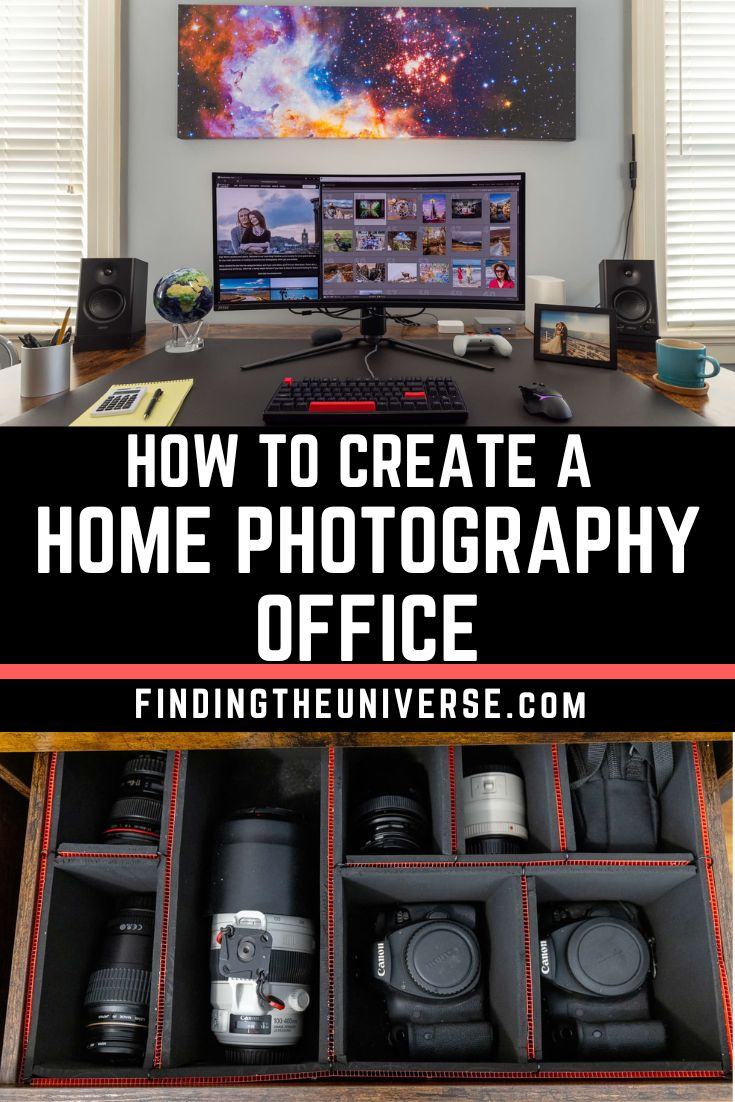I wanted to share a guide of how I designed and furnished my home office as a photographer. As a travel photographer, I spend a lot of time out in the world taking photos of beautiful places. On the flip side of that, I also spend a good chunk of time at home sitting in front of a computer screen editing photos and creating content like this.
Jessica and I bought our first house together last year and have been busy fixing it up and trying to make it a home. One of the first rooms I focused on was setting up my home office where I do the vast majority of my blog writing and photography editing.
Sure, it’s possible to work on the road. Personally though, I find that I get better results if I focus on capturing content on the road and creating content at home. Editing photos for example is certainly possible with a good photo editing laptop, but nothing beats a nice big monitor for editing photos, an ergonomic chair, and a powerful desktop computer.
I’ve also found that creating a dedicated home photography office helps separate work time from other time. My office is a place where I can get work done and really focus.
Obviously, function is important, and I wanted to design my office so if would fulfill all my main needs. For me, these included having a comfortable place to edit and organize my photos, an area for camera and photography equipment storage, a mini photography studio area, and a place to file paperwork and business documents.
Still, despite it being an office, where function is important, that doesn’t mean I can’t give it some personality. I spend a fair amount of time here, so it’s nice to make it personal to me, and be a place where I actively want to spend some time.
When we moved internationally, we came with no furniture and little equipment, so I had to start almost from scratch in terms of equipping, furnishing, and decorating my office. So I’ll go through all those decisions, what I chose to do, and some options for different budgets and styles.
In this guide, I’m going to go through what I think are the important things to think about when setting up your own home photography office. This is all based on my personal experience creating a dedicated office space for us in our home.
Whilst some of this content will be specific to working as a photographer, the majority of it will apply to any home office space. With so many of us switching to remote working in the last few years, I hope that you find the content in this useful for helping you set up your own home office space!
Things to Consider
Let’s first go over what you need to think about when planning your dream home photography office.
Size and Layout of the Room
The first thing you’re going to need to know is the size and layout of the room you have to work with. If you are lucky, you might have a choice of rooms in your room where you can setup your home office. However, if you’re like me, you likely aren’t going to have a vast choice of empty rooms to choose from.
In my case, there was a spare bedroom that I was able to utilize as a home office. For many people, turning a spare bedroom into an office can make a lot of sense. Maybe you have kids who have left the house, or you just have a spare guest bedroom that doesn’t get a lot of visitors.
It’s also possible that you don’t have an entire room to dedicate to a home office. Maybe the spare bedroom does get some use, so you have to leave the bed in there, or a sofa bed at the least. Maybe you have more of a hallway office situation going on or need to carve out a space in your family room or dining area.
My one piece of advice is to try to find at least a small dedicated area for yourself to work. Even if this is a small corner area with your own desk and storage, this is often nicer than trying to share a space with others for other purposes such as a kitchen table.
Whatever your situation, my suggestion would be to try to find the best option that works for you and the rest of your household. Once you have found a space, I’d suggest measuring it out. Graph paper can be useful to create a sketch of the space.
Once you know the size and layout you have to work with, you can start to plan things like furniture. After all, there’s no point planning on having a huge desk and dedicated studio area if you won’t have room for it. You’ll also be able to start planning exactly where you want to place different items of furniture in the room. Which leads me on to my next point.
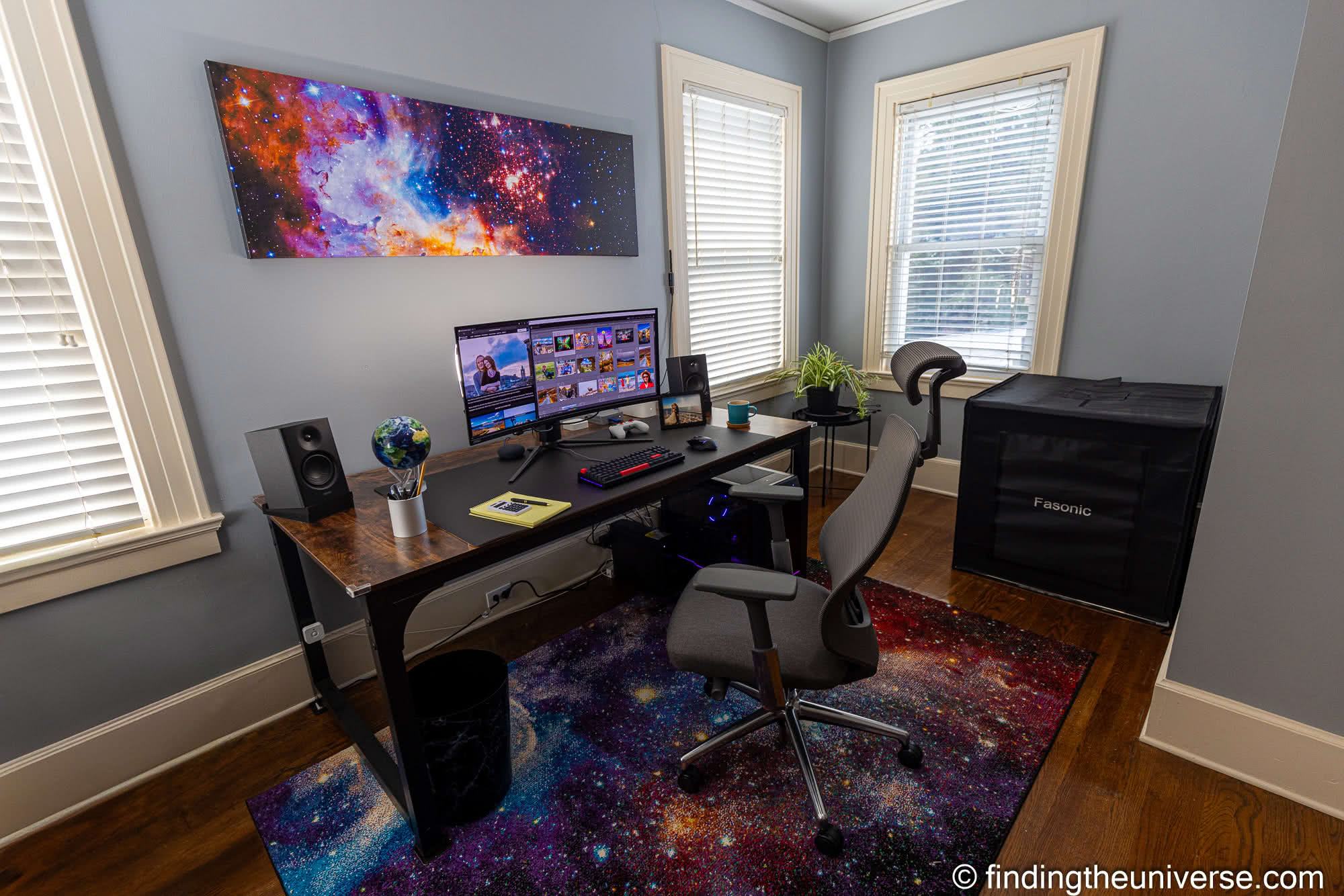
Light Sources
When designing your home photography office, one thing you are going to want to consider is the various light sources, and how you are going to be able to control them.
Most spaces are going to have a number of light sources, which may include windows, overhead lights, lamps, and so on. I recommend having a variety of sources of light other than just an overhead ceiling light such a a floor lamp, desk lamp, and natural light.
Having lots of light is going to be great for lots of type of activities you might want to do in your office and having some natural light can help boost our mood.
However, whilst it may seem like a good idea to always have a nice bright working environment, this can be problematic. First, for photo editing, you are obviously going to be working on a monitor. And the brighter the room you are in, the harder it will be to see the monitor. If you’ve ever tried to work on a laptop outside, you’ve probably quickly realized how hard it can be to see the screen.
If you work in a bright environment, you have to turn the brightness on your monitor up to compensate for it. This can have the unfortunate side effect of you editing your photos on a screen that is too bright, meaning that when other people see your images on their devices, or when you print your images out, they don’t look as you imagined them.
The other issues with lots of light sources is that they can cause annoying reflections on your screen. Even on a monitor with an anti-reflective coating this can create a distracting effect.
Now, I’m not suggesting you move your office to a basement and embark on a troglodytic existence (unless you are also using it as a dark room). Although that will give you lots of control over your lighting!
Instead, think carefully about the light sources in your office and how you can control them. Ideally, you don’t want any bright light sources like a window behind you, as this will likely reflect in your monitor. Having your desk facing the windows if you have any will help cut down reflections, if this is possible.
If it’s not possible, and even if it is, you’ll also want to look at how you can control the light situation. So this will be things like using blinds or windows shades that you can adjust when necessary, allowing you to darken the room as needed. Also, plan the lights in your room so they don’t create reflections.
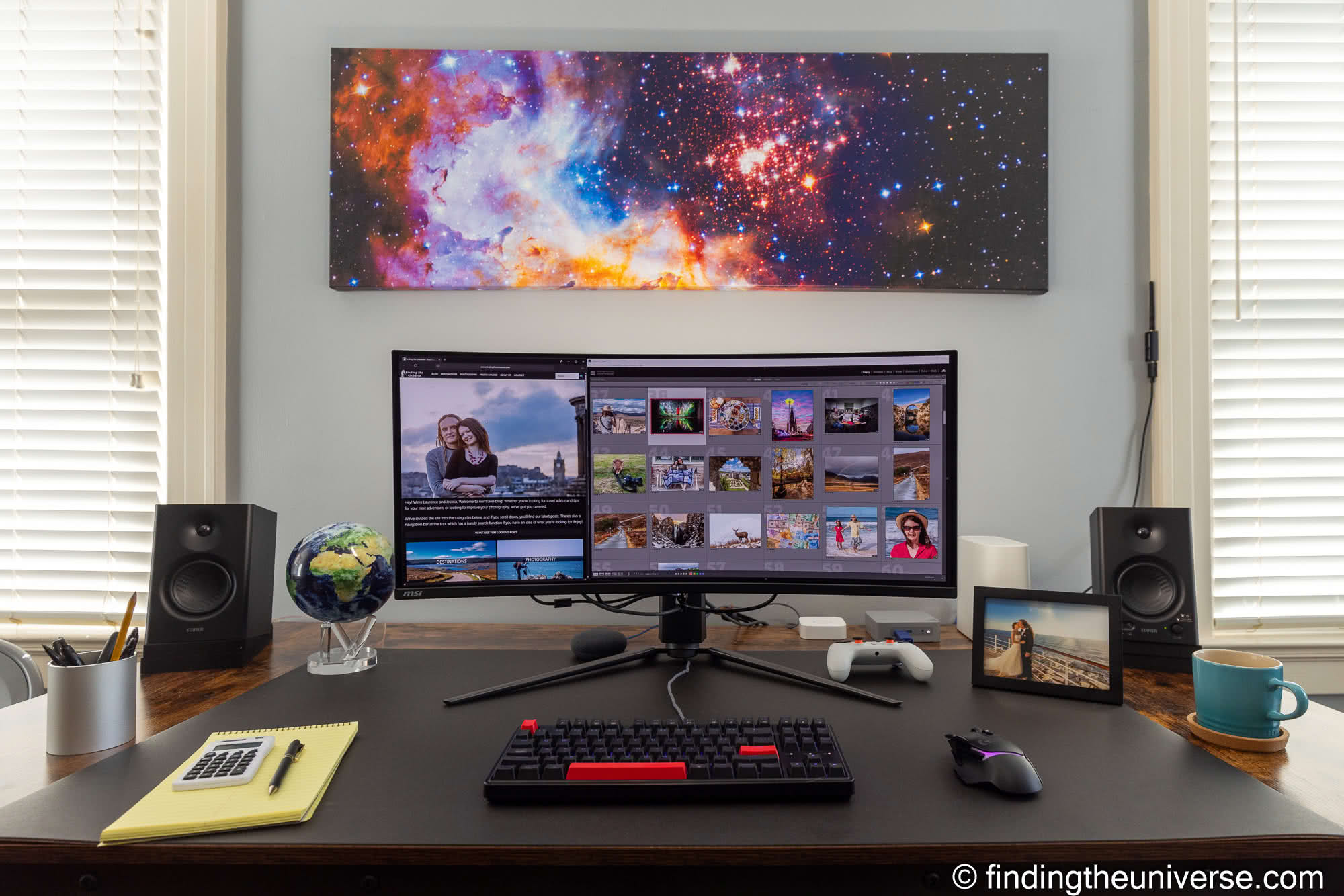

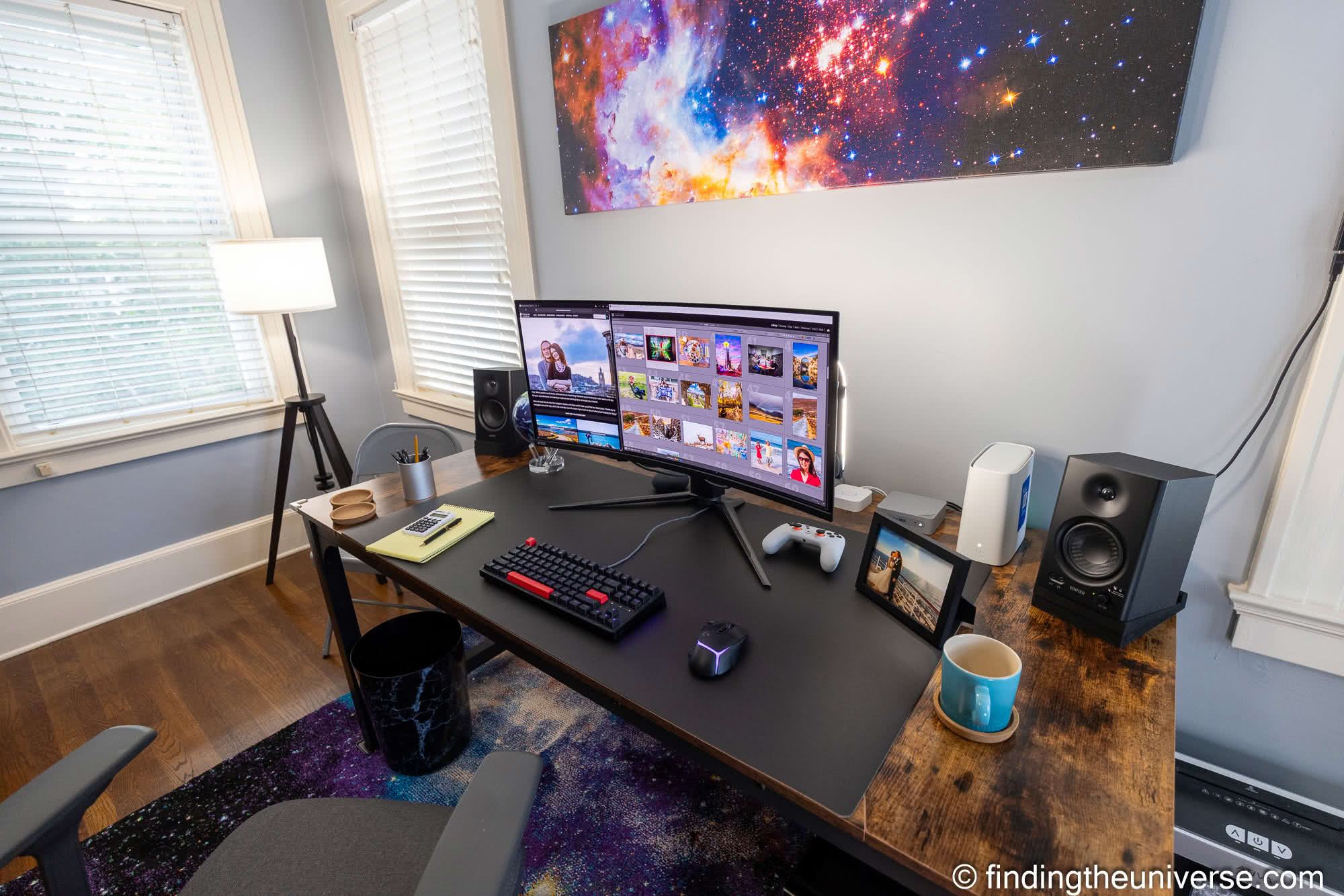

Noise
When planning your home office, you’ll want to think about what levels of noise you are happy to deal with, and what you can do to mitigate noise. From time to time for example I give video talks and presentations, and like many people who work from home I also have conference calls from my office.
Outside of those, I also prefer to work in a fairly distraction free environment if possible.
If you are choosing between various options for where your home office space is going to be, you will want to factor in the sources of noise in each area and if you think you can work with them. These may be external things like road noise or a neighbor’s dog, or internal noise like a lounge TV, kitchen noises, or your kid’s music.
Of course, there are different things you can do to control the noise entering your work space, including installing soundproofing materials like these. You can also wear noise cancelling headphones. However, starting off with a quieter space if possible is the best option.
It’s also worth mentioning that as well as external noise coming into your office, you should consider any noise you will be making and how that might affect the other occupants of your home. If you like to listen to music through speakers, or regularly take part in calls, locating your office in a location which won’t disturb other members of your home will be appreciated.
Storage Requirements
Any home office is going to need storage for things like documents, paper, pens and other office accessories. In my experience, a photographer’s home office also benefits from storage for camera equipment and accessories, from lenses and camera bodies to tripods, lights, batteries, filters, memory cards, chargers, cables, and more.
When planning out your home office and your furniture requirements, take into account everything you would ideally like to keep in your office. Don’t forget you’ll need storage for non-photography items as well, from paperwork to general office supplies. Think about the best options you have for storing everything, which might be drawers, shelves, filing cabinets, or something else.
Getting all your photography equipment stored in your office will make it easy to find and manage. It also moves it out the way of the occupants of the rest of the house, which can be a good thing for peace of mind.
How to Set up the Perfect Photography Home Office
Now I’ve covered the things you want to think about when planning your photography home office, I’m going to share some ideas for the key components you need. I’ll share what you need to think about for these components, as well as some recommended options based on my personal experiences.
Desk
One of the most important parts of any home office set up is the desk. You have a few choices to make when it comes to a desk.
First, and most importantly, the size of the desk. Obviously, this will be largely determined by the size of your room. If you have a larger room, then you’ll be able to fit a larger desk. If you have as smaller room, well, you’ll have to work with what you have.
To get an idea of the size that is best for you, I would write a list of all the things you would ideally want to sit on your desk and their size. This might include your monitor, keyboard, speakers, office organizers, mouse, computer tower, external hard drive, headphones, microphone, framed photos, coffee mug, desk calendar, plants, stapler, etc.
What else would you ideally like to be able to fit on your desk when needed such as your laptop, gaming gear, ring light, filming equipment, planner, or an extra monitor?
To save space, getting a desk where you can store things like your computer tower, speakers, and/or external storage underneath is a good idea. Just be sure when planning that your chair and legs will still have plenty of room.
For a home office I’d generally recommend a desk size that is no smaller than 48 inches wide and 24 inches deep. However, I personally believe that larger is better.
A wider desk will give you more room, so if you need to keep a notepad handy, or use a graphics tablet for example, you won’t be worrying about having enough space.
A deeper desk will allow for larger monitors, and a larger monitor can really benefit photo editing. If you have more than one monitor, then you definitely want to choose a larger desk.
So, if you have the space, I’d recommend looking at a desk that is more like 60 inches by 30 inches. Personally, I have a desk which is 71 inches wide and 35 inches deep and I love how much room I have.
There are also a number of other factors to consider. One of these is whether or not you want a standing desk. These have become very popular, with the idea that you can vary your position through the day from standing to sitting.
There are some downsides to a standing desk though, not least of which is cost, as a standing desk requires additional engineering to build and so obviously costs more. Some standing desks may also be less stable than regular desks and may not accommodate large monitors. You also need to think carefully about cable management with a standing desk and how you will manage the desk changing height with your setup.
You also have to think about if you want storage in your desk and how much you want or need. Drawers can be great for limiting the amount of stuff on your desk as you have places to store your pens, notebooks, paper, office supplies, extra cables, headphones, USB sticks, etc. The downside of a lot of drawers is limited space for storage under your desk. So think about if there are things you would ideally like to sit on the floor under your desk.
I personally chose a desk with no drawers as I wanted to be able to use the space underneath my desk for a large computer tower, Internet box, UPS battery storage tower, my office waste basket, and a bunch of cables. However, ideally I do wish I had at least a pencil drawer.
Finally, there are aesthetic decisions to be made, including what material the desk is made from, desk color, design style, and so on. Desks are available in all sorts of materials, including solid wood, engineered wood, and metal. Different materials will result in different prices, but this is primarily an aesthetic decision rather than a functional one. The main functional concern is to ensure it is a solid desk that will hold all the things you need and that it will hold up over time.
My main priority was getting a really solid desk at a good price. I initially thought I was going to get an IKEA gaming desk but when I went to get it in person I didn’t like the quality as it didn’t seem that solid. I also considered getting a simple vintage solid oak wood desk but there were practical issues given the size and weight of such a large heavy desk and getting it up our stairs.
I spent a lot of time researching desks, and I finally ended up going with this 70.8 x 35.4 Tribesigns desk. It is an engineered wood top set on a powder coated steel frame. It offered a great balance of size, weight, and price. It is a very sturdy desk and I have been pleased with it.
The other desk I seriously considered, and would recommend adding to your shortlist, is the Secretlab MAGNUS Pro. That’s an all metal desk which does include the sit to stand feature. It also has a really neat accessories system which works with magnets and which helps with organizing your desk.
Another popular brand that I looked at and which gets good reviews is the Uplift Standing Desk. They offer a range of standing desks with various options of color and material to choose from.
Finally, you can also get good value desks from somewhere like Ikea. A popular hack is to get a pair of Alex drawers, and then purchase a tabletop separately.
For me, it came down to wanting a slightly larger desk. I also really couldn’t justify the price difference for a more premium desk whose features I might not use that often, deciding instead to invest that money in a more premium monitor rather than the desk the monitor sits on!
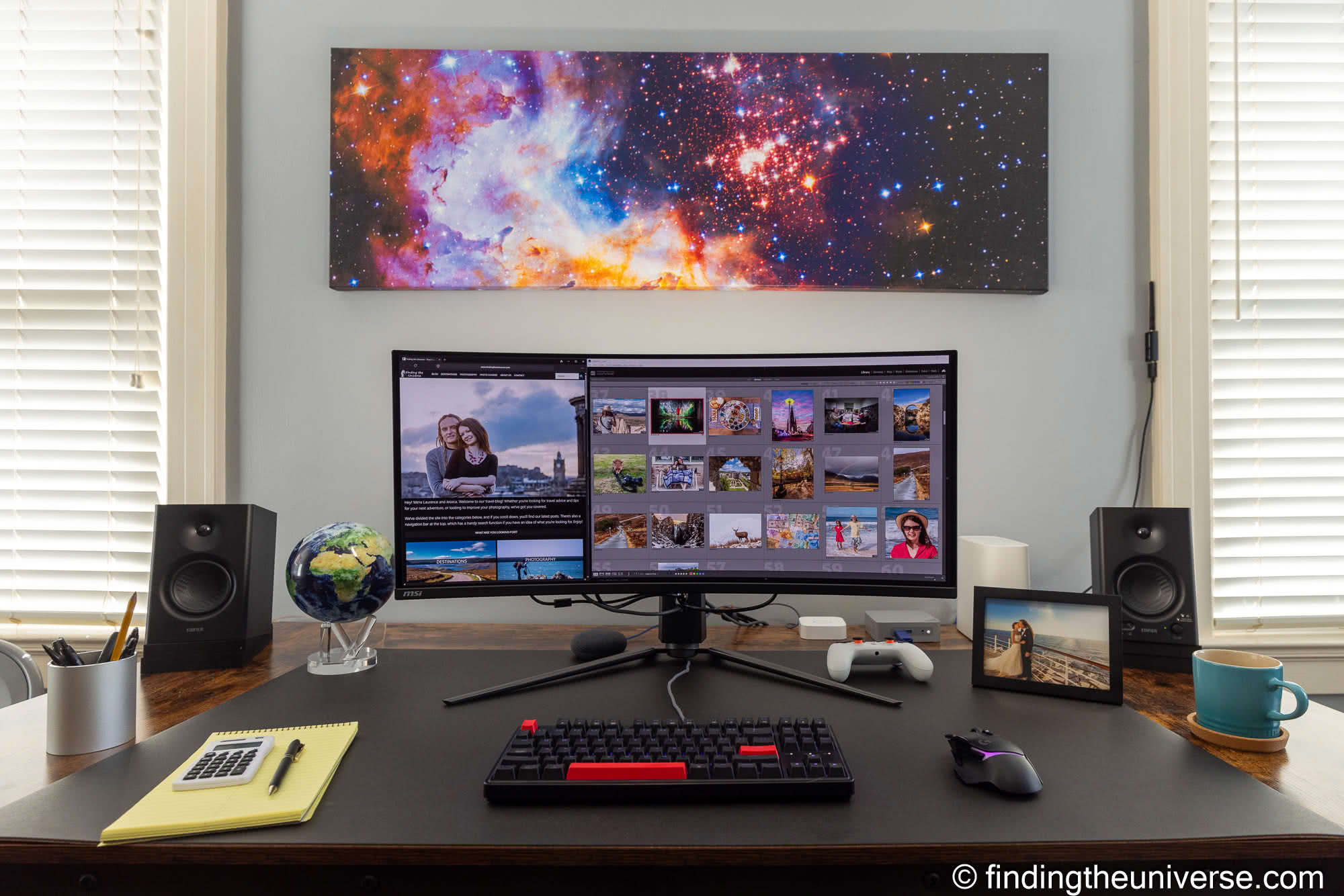

Chair
Another important decision you’re going to have to make when putting your home office together is a chair. This is where you are going to be spending a lot of your time, so it’s critical that you choose the right chair.
Having been down the chair rabbit hole myself, I should warn you that there is a lot of choice out there. There are also seemingly endless office chair reviews out there which are going to have you second guessing yourself.
The main things you will want to decide are what material the chair is made of (foam vs mesh are the main decisions), and then things like whether or not the chair has armrests, a headrest, what type of upholstery, and how adjustable it is.
Chairs, like seemingly everything in life, are available at a wide price range, from under $100 through to well in excess of a thousand.
I did a huge amount of research when purchasing an office chair. I concluded I wanted a headrest and armrests, a mesh back for air circulation, adjustable height and back, and a foam base for comfort and longevity. A price sweet spot seemed to be between $200 and $500 for a good chair that would last me a while and offer all the features I need.
In the end I settled on this office chair, which I have been very happy with. The seat is very comfortable, it’s adjustable in all the ways I could want, and it is very well built and solid.
From my research, other chairs that you might consider include the Herman Miller range and Steelcase chairs. Both these manufacturers make excellent chairs but they are definitely more expensive options. The good news is that you can sometimes find them used or refurbished for a better price.
Other well reviewed mid-range options include chairs from Branch, Humanscale and Haworth. At the more budget end of the spectrum, look at brands like Sihoo and Staples. The Staples Hyken chair in particular offers great value.
The main thing to remember when choosing a chair is that everyone is different, and so the perfect chair for me is unlikely to be the perfect chair for you. So keep this in mind when reading reviews and getting advice. In an ideal world, you’ll want to visit a store that actually sells a variety of office chairs so you can try them and see what works.
The next best option is to buy a chair from a store with a no questions asked free returns policy, so you can return a chair if it doesn’t work out for you.
If you are a particularly small, large, or tall person, I would encourage you to pay closer attention to reviews for people of similar size and build. For example, Jess is a tiny person so most office chairs are not particularly comfortable for her as they are built for someone larger and taller than her. Some office chair brands offer some of their chairs in different sizes such as Herman Miller, Haworth, and Steelcase.
From a photography perspective I would say there is nothing specific you need for a photography home office chair compared to a regular home office chair. You just want it to be really comfortable and supportive for long periods of sitting down.
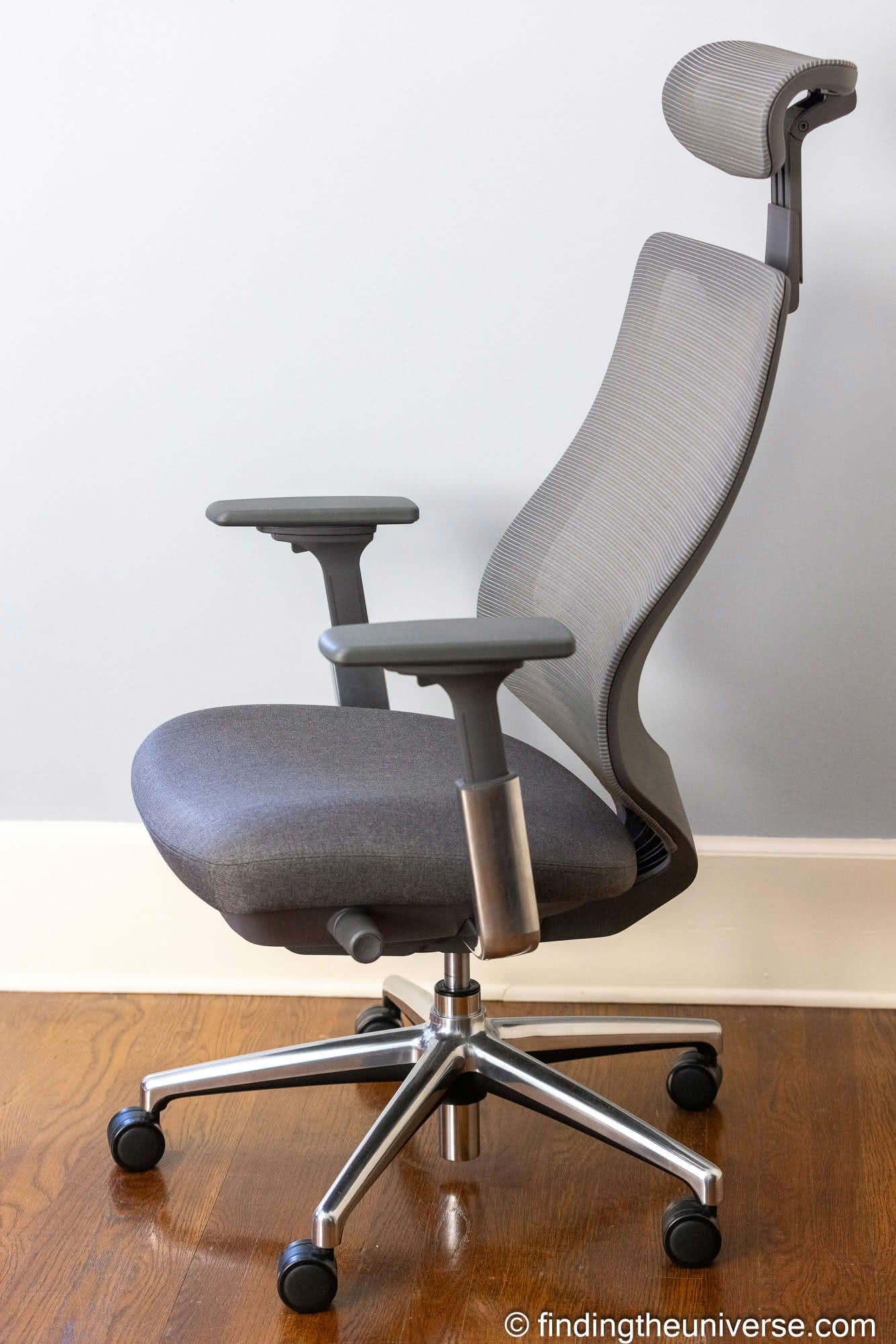

Computer & Monitor
A computer is pretty much an essential item for any home office, but especially so for a home photography office. This is where you are going to be doing all your photo editing, a task which requires a pretty powerful computer and a high quality monitor.
I’ve already put together a guide to the best photo editing monitors, so I won’t replicate that information here. That has everything you need to know to choose a good monitor for your photo editing needs, including the specifications to look for and what is important. It also has a number of recommended models at various price points.
I would also add when choosing a monitor to also consider what else you plan to use it for. If you are going to be using for anything else beyond photo editing, such as watching movies or TV shows, or even gaming, then you might want something that is good across a range of tasks.
As an example, many photo editing monitors have lower refresh rates, say around 60Hz. Whilst this is fine for photo editing, it can result in issues when playing computer games. So, you might consider a monitor with a higher refresh rate that works for both photo editing and gaming.
Size wise, I’d suggest something in the 27″ – 34″ range, although this will depend on the size of your desk.
I ended up going with an MSI 34″ ultrawide OLED monitor, which works well for everything from photo editing to gaming to consuming content.
For the computer itself, I do have a guide to choosing the best laptop for photo editing. I would recommend reading that guide as it covers which specifications are important for a photo editing computer and why. However, rather than buying a laptop, I would personally recommend a desktop computer for home office use.
Desktop computer components are nearly always more powerful than their laptop counterparts, as they don’t have the same size and thermal restrictions as a laptop. However the naming convention is the same, so my laptop guide will still prove useful.
I actually built my own desktop computer from parts as it’s something I enjoy doing (and have a computer science background). However, you can purchase excellent pre-built desktop systems. Just be sure to check that the specifications include a recent processor from Intel or AMD, a discrete graphics card (GPU), at least 32GB of RAM, and a 1 TB SSD. Again, check my guide to the best laptop for photo editing for the specifications that matter.
Brands to check for desktop computers include Dell’s range of Alienware desktop computers, Apple’s Mac Pro range of desktop computers, HP Envy desktops, and MSI gaming desktops.
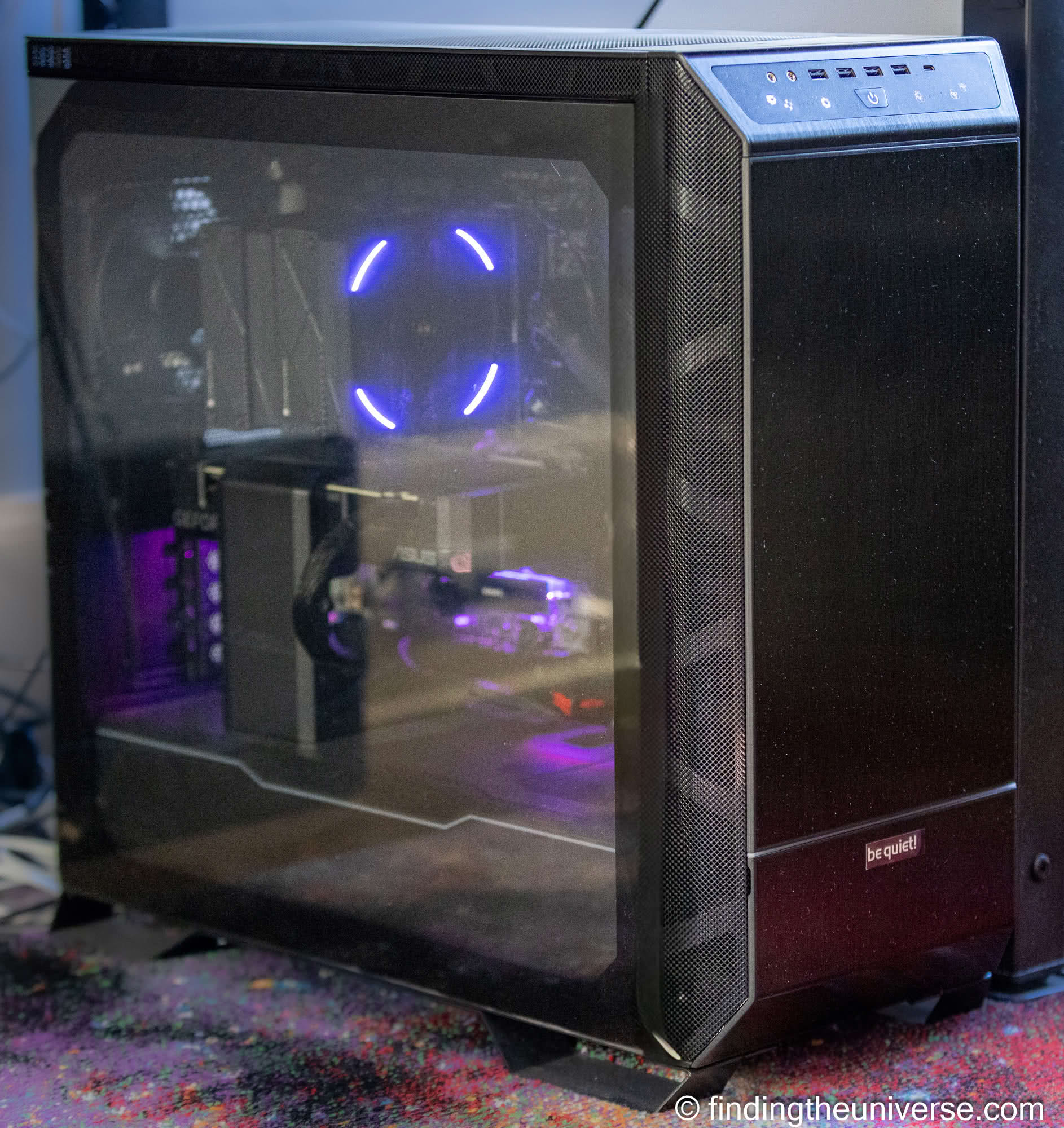

Lighting
Lighting is important for any office, but particularly so for a home office where you plan to do photo editing, as outlined previously in this guide. I recommend having your lighting coming from a number of different sources (e.g., floor light, desk lamp, window, overhead light, etc.) and being able to control that light as needed (e.g., dimmable bulbs, blinds, diffusers, etc).
In terms of actual lighting suggestions, I have a couple of ideas. First, I would advise a monitor bias light. This goes behind your monitor and bounces light off the walls around you to create a diffuse light source that will reduce eye strain.
I’d also suggest one or more floor standing lamps. You can place these in strategic places around your office to provide light as required. I’d also highly recommend getting a lightbulb that lets you change it’s color temperature, from warm to cool, and which is also dimmable.
This way you can change the lighting in your room depending on your mood and needs, and to ensure a neutral background light when you are editing your photos. I like these Philips Hue bulbs for this purpose. You can also get bulbs like these which change color across the RGB spectrum but those aren’t really necessary.
For photo editing, you want to ensure that your room lighting is not affecting your color perception, so having lighting in the range of 5000K – 6500K (to match your monitor calibration) is going to be ideal. But you might not want a cooler tone all the time, so having adjustable lightbulbs is a good idea, so you can have a more normal warmer light when not editing.
Useful Accessories
There are a few useful accessories that I have which you might consider for your home photography office. In no particular order, these are:
Desk Pad
A desk pad, as the name suggests, is a large pad that sits on your desk. It’s a bit like a mouse pad, but larger. It can make the working area a bit more comfortable and is a better writing and typing surface. If you have a more budget table like I do or a worn one, a desk pad can also be a clever way to disguise that fact and protect the surface from damage.
Desk pads can also be customized so you can do anything from monogramming it to choosing an artwork you like. They’re also available in all sorts of material, including felt, leather, cork, vegan leather, and wool, and in myriad colors and designs.
You can see and shop a variety of options on Amazon here and on Etsy here.
Personally, I went with a Grovemade desk pad in natural linoleum with a cork backing. I really love all the material choices they offer including leather, natural linoleum, cork, and wool. I chose a simple black because I already have a pretty dramatic canvas print and rug choice in my office, and didn’t want to go entirely crazy. But as with everything, it’s your office, so go with what makes you happy!
Mouse
I actually think a good mouse is a really important accessory for photo editing at home. I particularly recommend you buy a gaming mouse. The reason for that is because most gaming mice come with lots of extra buttons, which you can assign to keyboard shortcuts. I use these to speed up my photo editing workflow, with common Lightroom shortcuts that I use all the time assigned to specific buttons.
I specifically recommend the Logitech line of gaming mice , which I have been using for many years, with my personal favorite being the G502. This is available in a number of varieties. I prefer the wireless version as I find it easier to move without a cord. But it’s also available corded, and I had the corded version for years.
I’d also add that if you decide against a desk pad, then I can recommend getting a nice mouse pad for your mouse instead, which will improve accuracy and protect your desk surface.
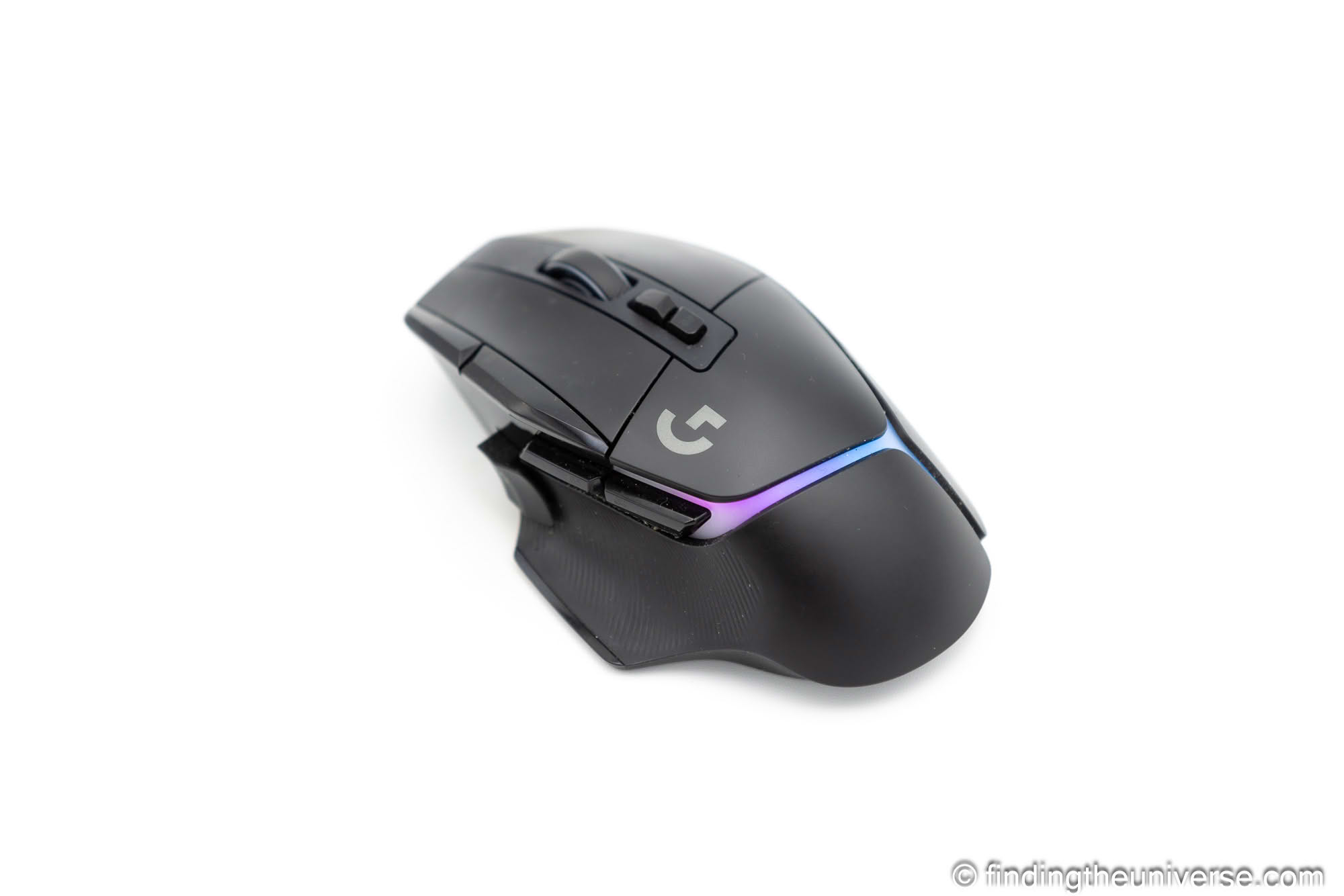

Monitor Calibration Tool
If you are serious about your photo editing, it’s important that your display is correctly calibrated. This is particularly important if you plan on having prints of your work made, as it will ensure that what is printed matches what you see on your monitor.
I have a whole guide to monitor calibration here, but the key takeaway is that for the best results you should use a hardware monitor calibration tool like one of these, which is what I use.
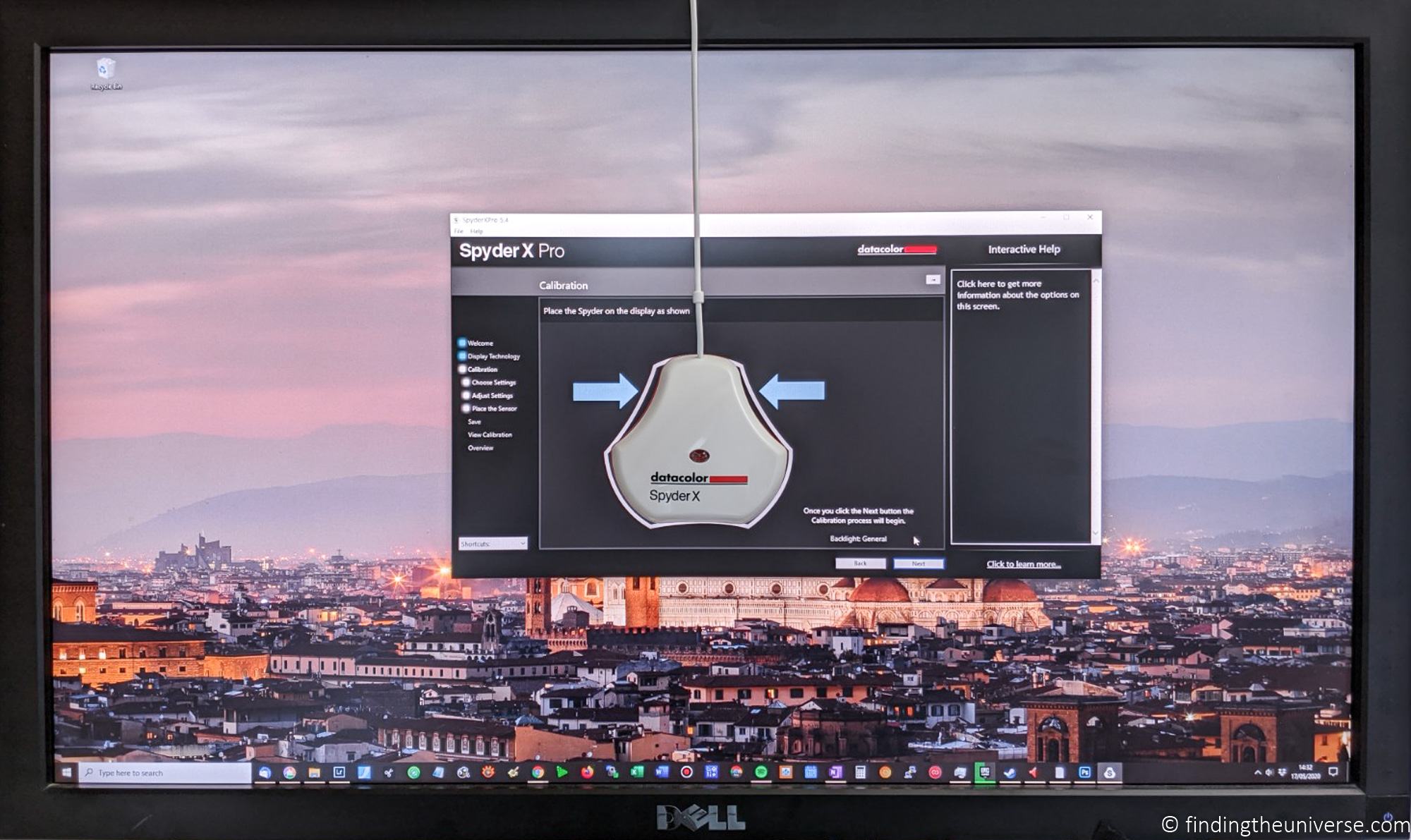

External Hard Drive / Network Attached Storage
A backup system for your photos is an essential part of your home photography office setup. If your computer stops working or a hard drive fails, you don’t want to lose all your images.
I have a complete guide to backing up your photos, but the key takeaway is that you need two backup systems in place. First, you need a cloud backup that stores your digital image files offsite. This will protect you in case of a disaster at home. I use and recommend Backblaze, but there are other options.
You should also have a local backup system in place. This will let you get a quick restore of your image files should a local drive fail. A large external hard drive or network attached storage device is the best solution in this case. Personally I have a large external drive I use for on-site backup.
How to Store Camera Equipment
If you’re anything like me, then you probably have a fair amount of photography equipment to store away. Prior to setting up my home office, my camera gear primarily lived between various photography bags I had. This did keep it protected, but wasn’t an ideal solution as I had to go rooting through bags to find what I needed for any given shoot.
It also meant that if I needed that specific bag, I’d have to move everything out of it. In my research for storing my camera gear at home, I came up with a few options.
Ideally, you will have a more permanent storage area in your home that will keep your cameras and photography gear organized, safe, free of dust, and protect it from damage. You want to keep it out of direct sunlight, away from water and humidity, and in a place with stable normal temperatures.
Using Camera Cases
One thing many photographers have is a camera bag, or, if you’re like me, a variety of camera bags for different scenarios. These might include backpack style bags like these, hard cases like this or this, and roll on bags like these. I happen to own all of these types of photography bags and cases.
For storage I particularly like this hard case which is also highly recommended for storing photography items when moving or doing shoots in rough terrain locations. Personally, I concluded that the case would look a little out of place in my home office. Instead, I use it for storing extraneous gear in a closet, where I also keep other items I don’t need on a regular basis like my photography bean bags, extra tripods, extra cables, photography bags, and so on.
However, if you already have a spare camera bag or two, and you don’t have too much gear to store, then using these can be a good option to store your gear in between shoots.
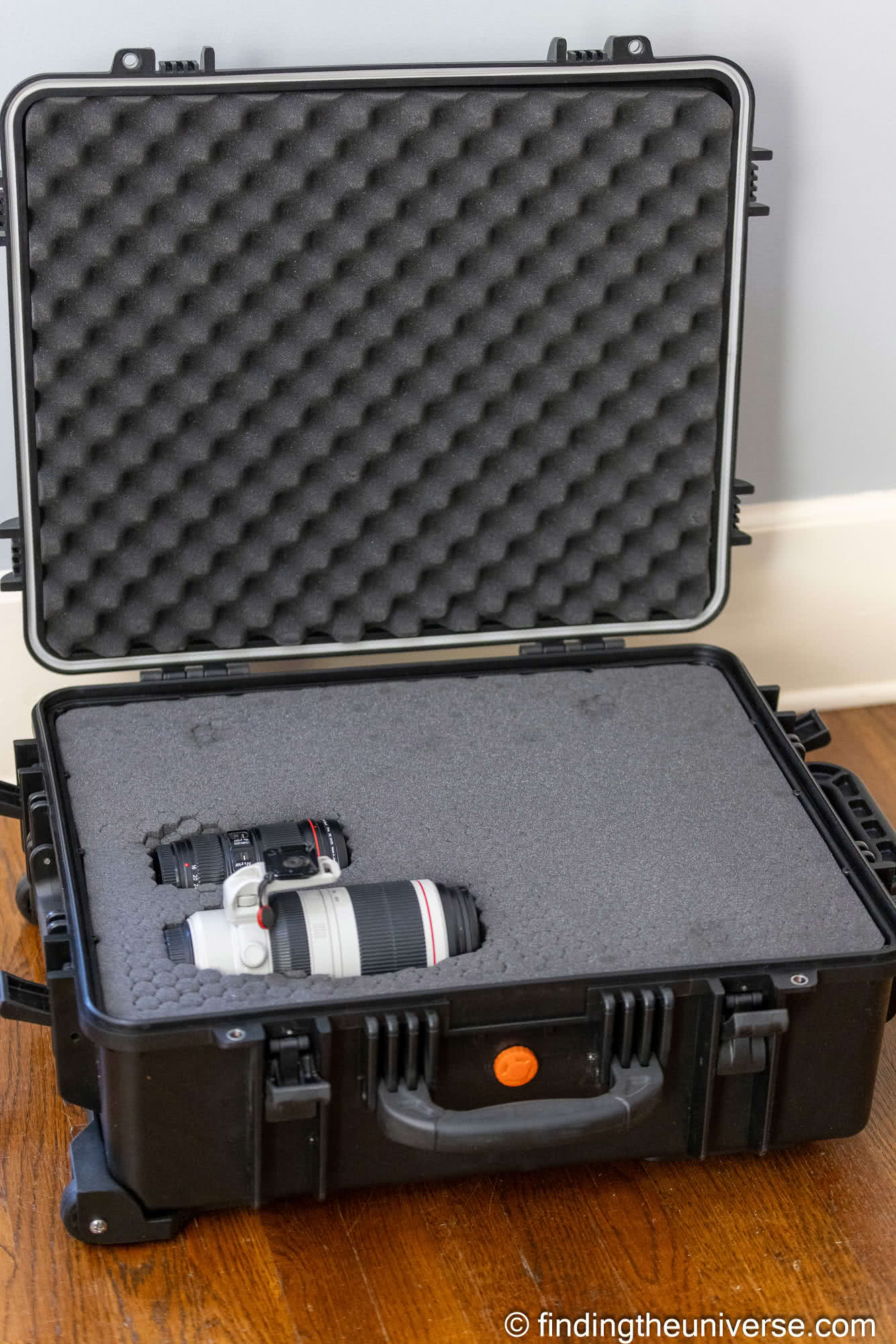

Cabinets / Drawers
The next option to consider is to use cabinets or drawers to store your photography gear. These look more natural in a home office setting, and they are available in a huge range of sizes and materials.
The downside of using cabinets or drawers is that generally the drawers are not designed to store camera equipment specifically. So the drawers might not be deep, tall, or wide enough for your equipment. Additionally, most drawers are not padded or set up in a way that provides any protection for camera equipment.
Some kind of padding or protection is essential for your gear as you don’t want it moving around or bumping around in a drawer when you open and close it as that could lead to damage. So you will likely have to add some kind of padding and divider system, which will take up additional space in the drawers.
A popular option I found that people like to use in existing drawers is the Pelican TrekPak Divider System. You can also create your own system, either from scratch, or using internal camera unit storage solutions.
If you do decide to go down the cabinet / drawer route, you will want to consider the size of your equipment and how it will all fit into the solution you purchase.
Other factors to consider are how sturdy and secure drawers are (can they be locked for example?), the material they are made from, and of course the price.
One popular option is to adapt a tool chest for your camera gear. Most tool chests are well made, constructed of durable metal, and can be locked as they are designed to store and protect high value tools. There are many brands available, such as Husky and Kobalt, with a wide range of products available.
Of course, you can also purchase a cabinet or chest of drawers from a furniture store and work with that. Just be sure it is large and sturdy enough to accommodate your storage needs.
My Home Office Camera Storage Solution
For my office, I wanted a solution that would let me store my camera gear in an existing set of drawers. I decided that a set of drawers wouldn’t look out of place in an office, and I was able to find this set of drawers that matched my desk, and were within budget. They are designed for clothing storage and have deep drawers, which meant they had the dimensions I needed to store all my equipment.
However, for this to work I would need a solution that provided protection and prevented equipment from rolling around when the drawer opened, as most drawers are not generally designed to keep camera equipment in.
I really liked the look of the Pelican TrekPak Divider System. However, I calculated that I’d need at least four of them to hold my gear, making the cost somewhat excessive in my opinion. I also looked into using ICU systems like these, but again the cost would end up being a bit higher than I wanted.
My solution was to create my own system. I purchased this neoprene adhesive sponge foam, this corrugated plastic, some 1″ acoustic foam for the base, and some stiff craft wire to create the pins which hold it all together. A few careful hours with a sharp knife and measuring tape later, and I had built my own camera drawer storage system where I can keep all my camera gear and accessories.
As previously mentioned, I also use my existing hard case for storing extra gear out of the way that doesn’t fit in the drawers or is more rarely used.
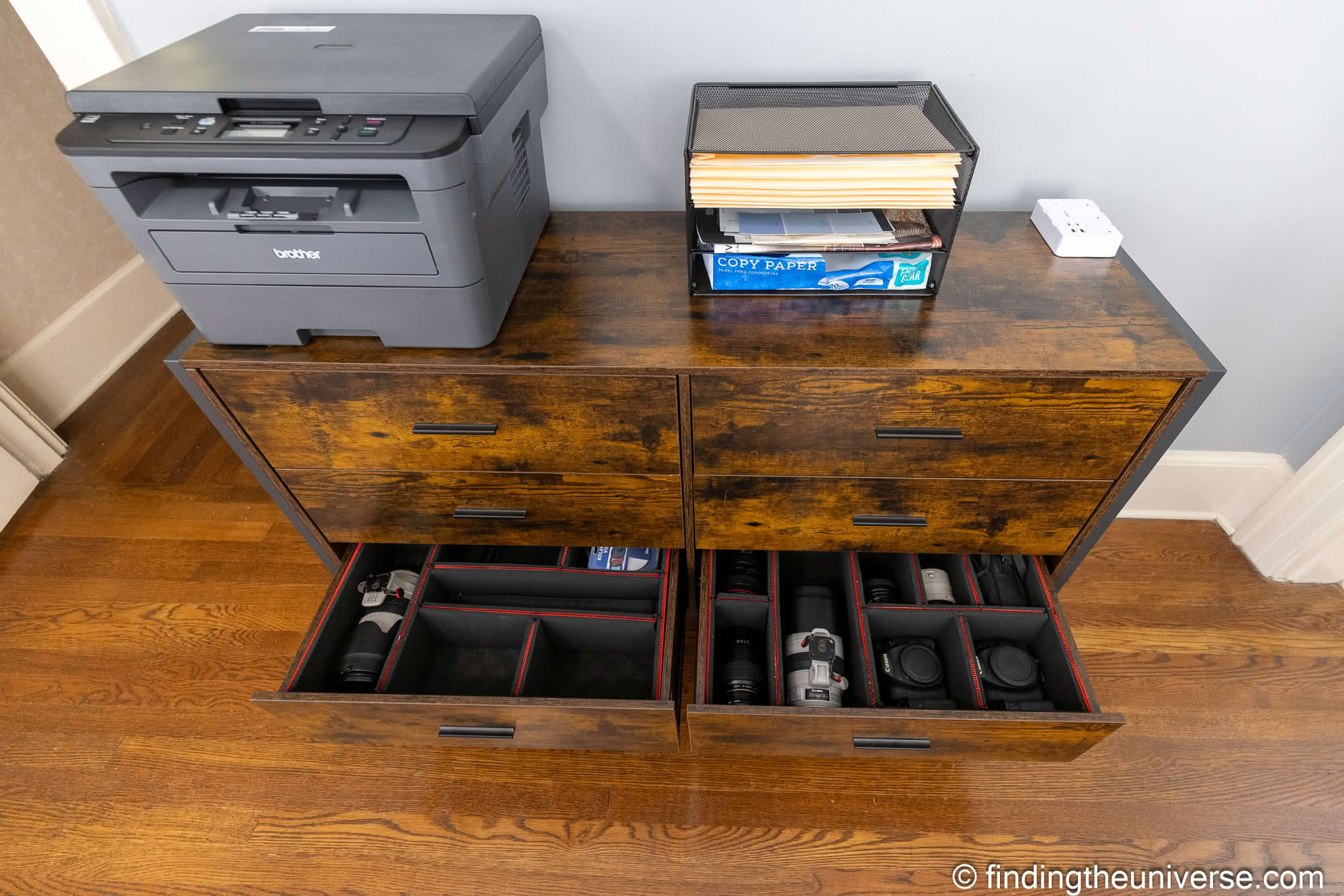

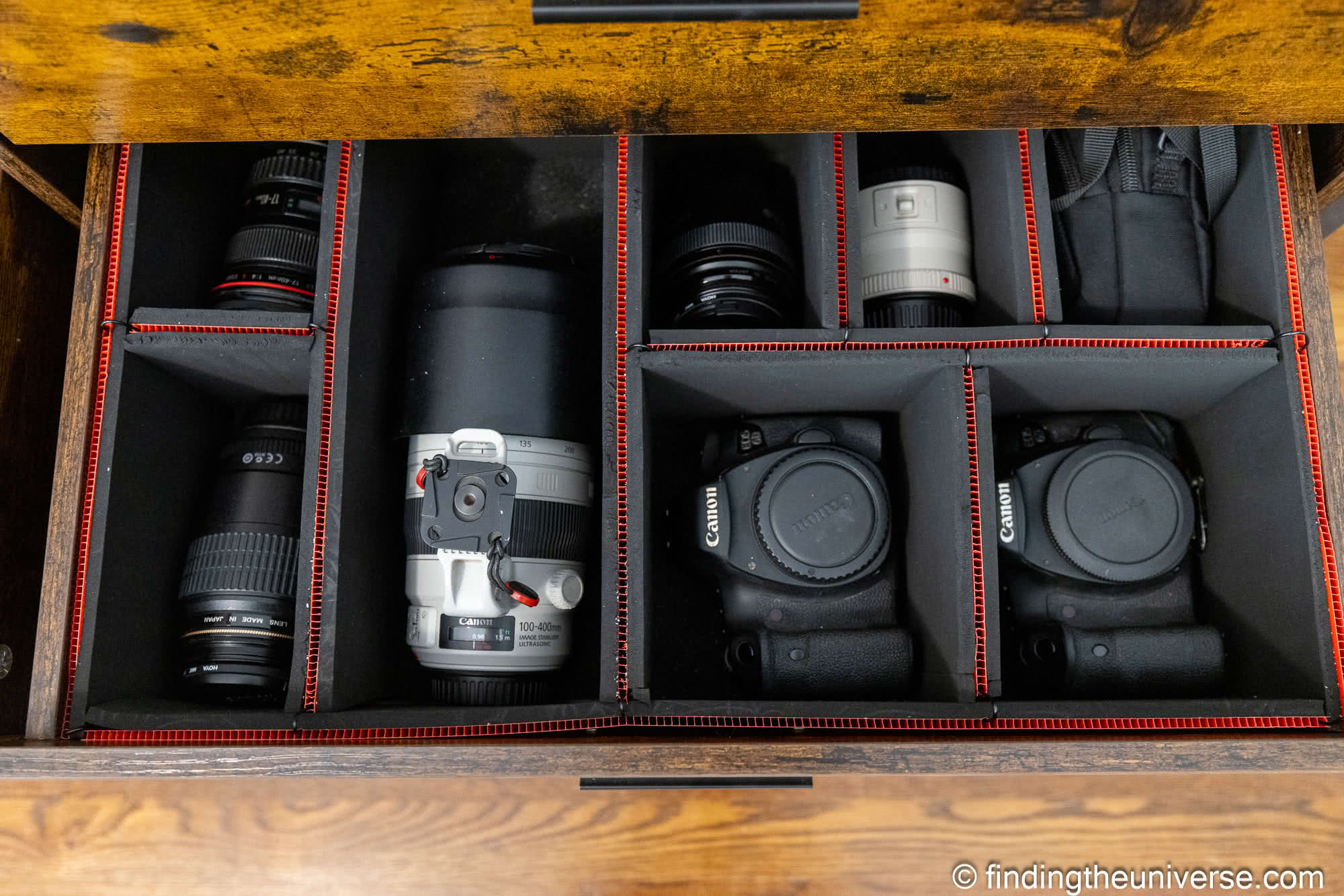

Filing Cabinet
Whatever you use your home office for, the reality is that you are going to need some kind of storage for paperwork. If you regular print photos, then you’ll probably need a space to store and file them. if you do film photography, you’ll need a safe and clean space to store film and negatives.
Even if you don’t print out your photos often, you’re likely going to have business paperwork and receipts that need filing, as well as bit and pieces of electronic gear and adaptors that need somewhere to live.
If you don’t have much of this, then you might consider getting a desk with a file drawer if that is all you need. But if you think you might need more than one drawer of storage, I’d probably opt for a separate filing unit.
Personally, I like having a filing cabinet to keep all my paperwork filed away neatly. You can pick up filing cabinets online, but they are also an item that can easily be purchased (if you have the right vehicle) at a thrift store or second hand somewhere like Facebook Marketplace. Often, the secondhand models are going to be clearance models from old offices, and will be a pretty high quality.
All that said I ended up getting mine online because my car isn’t big enough to fit in the size of filing cabinet I wanted. I got a locking lateral three drawer filing cabinet which went together pretty easily and does the job.
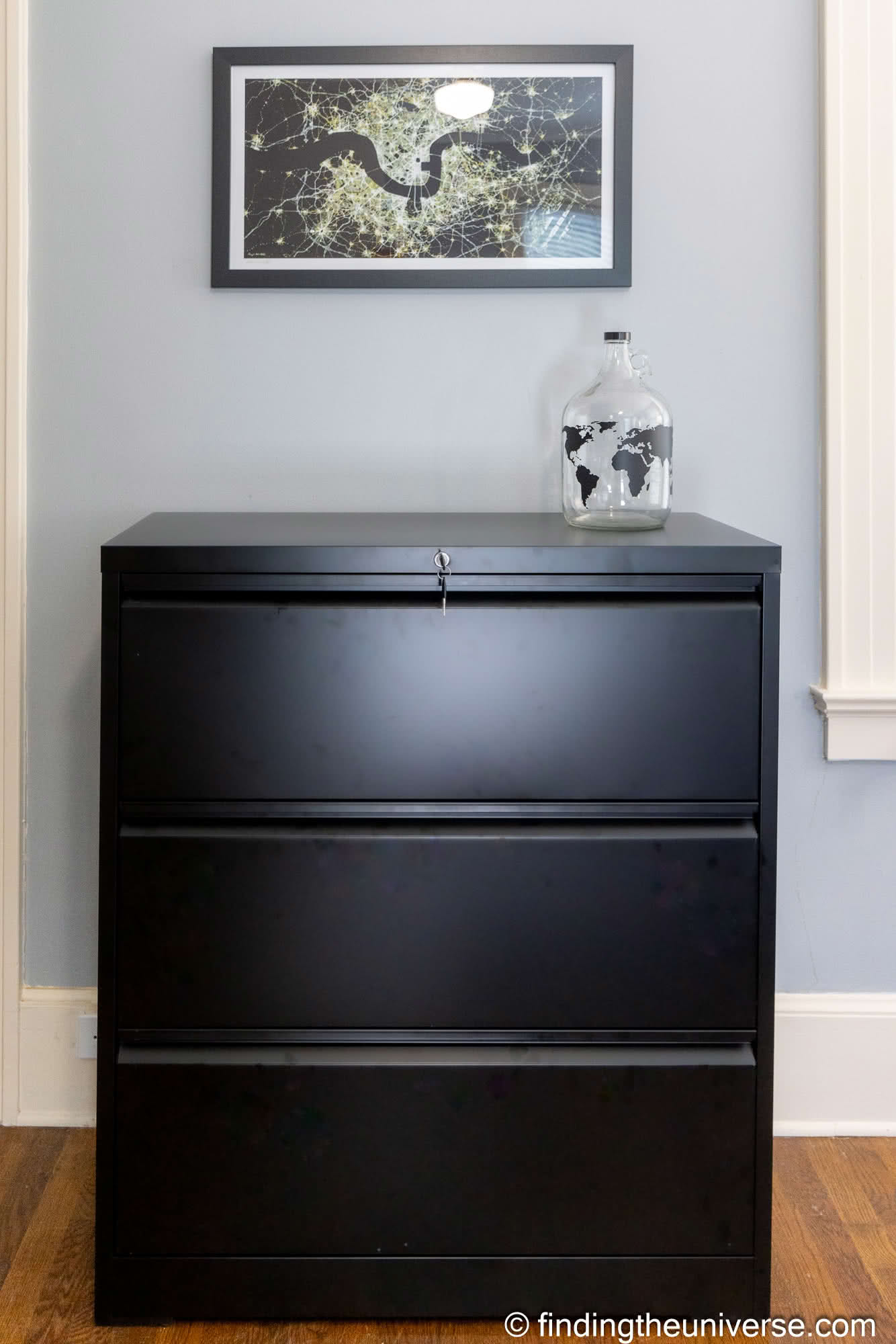

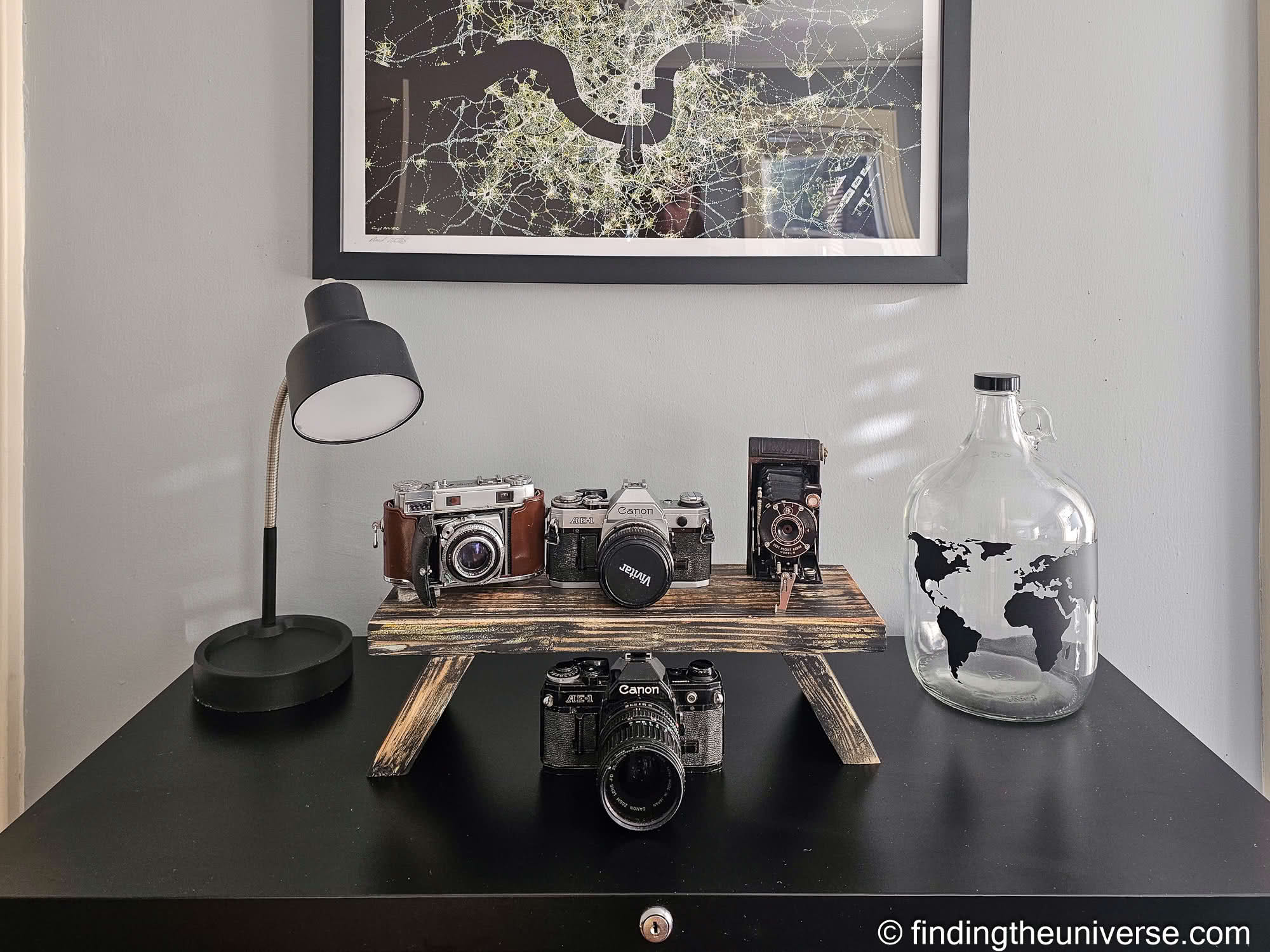

Light Box / Studio Setup
Depending on the type of photography you do, you may want to incorporate some sort of studio setup in your home office as well so you can take the photos you need.
For example, if you do portrait photography, then putting together a dedicated area to do that would be a good idea if you don’t have a dedicated studio space. You’ll need studio lights and a backdrop against which to shoot. A pull down backdrop can be a good idea if you don’t have a lot of space but have a blank wall.
Personally, as I’m primarily a travel photographer I don’t do a lot of photos that require a home studio setup. However, I do review products from time to time, and being able to take photos of them in a controlled lighting environment is handy. For this purpose, I use a large photography lightbox.
This is basically an enclosed cube with built-in high powered LED lights and a white backdrop which allows me to take photos of things like camera straps, photography bean bags, and more. We also use it when Jess reviews travel related products like travel jewelry, travel scarves, or travel journals.
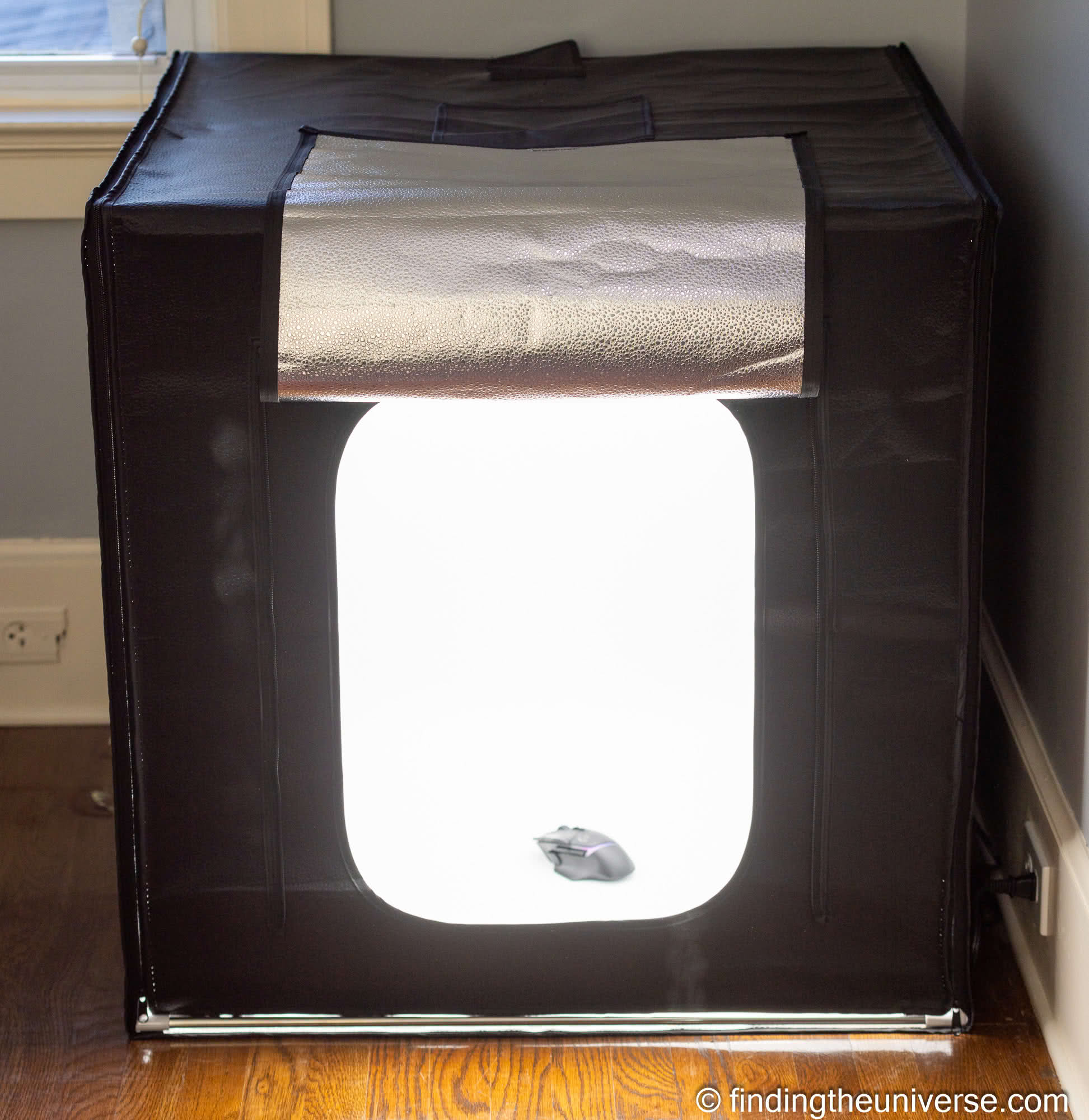

Printer
If you plan on printing your photos at home, then you’ll want to invest in a good photo printer. There are a number of options to consider, with key decision points being your budget, and the size of prints you want to print
Options to consider include the pricey but impressive Canon imagePROGRAF PRO-300, the fairly reasonably priced Epson EcoTank Photo ET-8500 or, for those of you on more of a budget, the Canon PIXMA TS7720.
One thing to bear in mind when purchasing a printer is that you will also have to pay for suitable paper as well as printer ink. Both of those supplies can quickly increase the cost of your print.
Personally, I use a photo lab for printing my photos. It’s more convenient, and it also gives me access to a huge array of print mediums. I generally use SmugMug for my photo needs. I also host my image portfolio with them, and if someone orders a product they handle all the printing and shipping for me. You can see my detailed SmugMug review here.
All that said, I do still have the need to print things out at home from time to time, but these are paperwork rather than images. So I ended up purchasing a wireless black and white Brother Laser Printer. I’ve had one of these for years, first in the UK and then in the USA.
Whilst the upfront cost of a laser printer is a little higher than that of an inkjet, the ink toner cartridges last forever, meaning in the long run it is way more cost effective. I also highly recommend a wireless printer so you can have more flexibility in where you place it in your office.
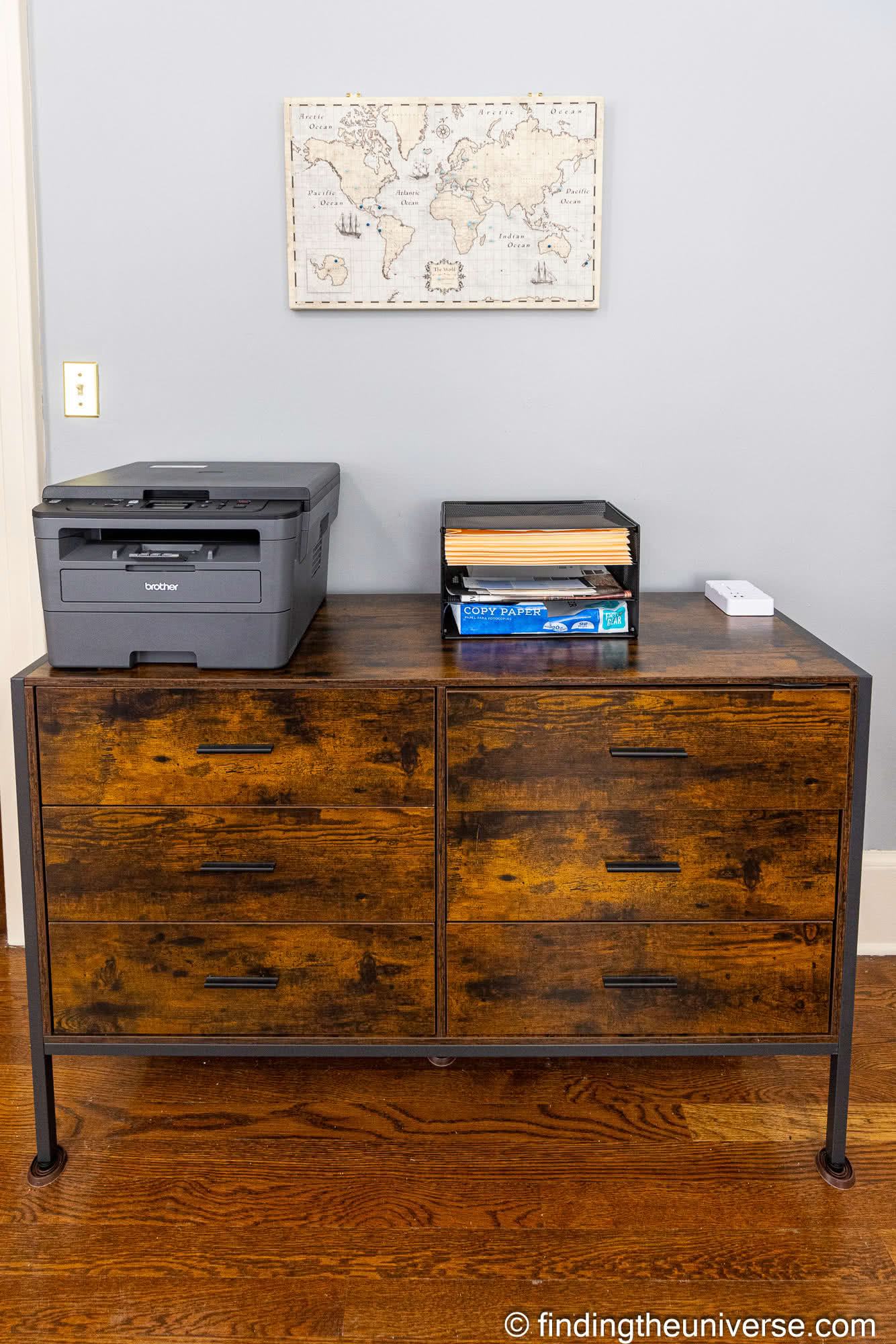

Other Accessories
There are lots of additional accessories you might consider for your photography home office.
Office supplies and organization tools
If you are running a business like I am or just pursing a passion, you’re still going to want some basic office supplies such as pens, stapler, writing pads, paper clips, printer paper, scissors, surge protectors, and the like.
While not exciting, you are also going to want to keep your office organized so you can easily find things. I found that when I just threw stuff in drawers in the past, I was often losing things or buying duplicates of things I already owned.
So these are things like pen holders, file folders, file organizers, drawer trays, wire organizers and cables, and the like. I would evaluate what all you need in your office and then figure out what type of organization tools would be best for you and your space.
Artwork and personal touches
You are likely going to be spending quite a lot of time in your home office, so you will want to personalize it to your tastes and give it some personality. It is the one room of the house where my wife has given me pretty much free range to decorate how I want.
Some of the things I love are space, travel, science fiction, gaming, and photography, and my favorite color is purple. If you came to my office, you would probably be able to pick up on most of these things pretty quickly.
Personally I’m a big fan of space, so I added a canvas print of a James Webb image (freely available from NASA), as well as this galaxy themed rug under my desk.
In relation to travel I have a MOVA globe on my desk, a world map pin board above my camera storage unit, a map artwork by local artist David Nuttall above the filing cabinet, and a large glass jug with a world map on it atop my filing cabinet.
In relation to photography, I have displayed some of my old cameras on the filing cabinet. I also have a framed wedding photo on my desk. I am also likely going to frame some of my photos in the future for one of my blank walls.
Gaming wise I haven’t chosen a particularly strong gamer aesthetic, although my PC case does have a bit of RGB lighting, and I have a game controller within easy reach! The nice thing about building a photo editing PC is that it happens to double up well for gaming as well.
The color purple is scattered throughout the room. I even have a purple dragon door topper peeking from atop of my door.
Of course, you’ll want to personalize your office in a way that suits you, which could mean anything from hanging prints of your own work, to other artwork or decor. If you do want to display your own images, don’t feel restricted to print, it’s amazing what you can put images on these days from coffee mugs to rugs to metal.
The main thing though is to make your office a place where you enjoy spending time.
Plants
I love having some greenery in my office and it can really add some visual interest and naturalness to what can be a pretty utilitarian space. You want to go with hearty plants that don’t require too much maintenance. And ones that can thrive indoors in the amount of light available to you in your office space.
I personally favor spider plants as they have proven difficult to kill, and it is a plant that just keeps giving as I start with one and soon have half a dozen of them. I keep mine in a plant pot that sits on a black metal drink tray stand next to one of my windows.
Now, if you don’t have much light or know that you won’t be able to care for a live plant, then I recommend looking for preserved dried flowers and greenery. These are going to look better than fake ones and don’t require really any maintenance, just occasionally blowing them with some air for dusting. Dried and preserved flowers can last for years in a climate-controlled space.
MOVA Globe
One of the things on my desk which I noted above is a MOVA Globe. We first saw these magical contraptions whilst traveling in Venice, Italy. They are powered by solar energy and will spin when they have enough natural or artificial light.
They are powered by solar energy and will spin when they have enough natural or artificial light. They are a very fun addition to a desk, especially if you like travel as much as we do.
If you’re interested in purchasing one, we have been given a 5% off discount code that can be used for any 6 inch or 8.5 inch MOVA globe purchased from their website. Just put in coupon code TRAVELCATS at checkout.
Scents
You may also want to work in a place that has your favorite scent. Fresh flowers can be one way to infuse some nice scents to your office. You can also go with candles, potpourri, diffusers, incense, wax melts, etc.
One of my favorite scents in sandalwood so I have one of those scent diffusers on my desk with the little wooden sticks and sandalwood essential oils.
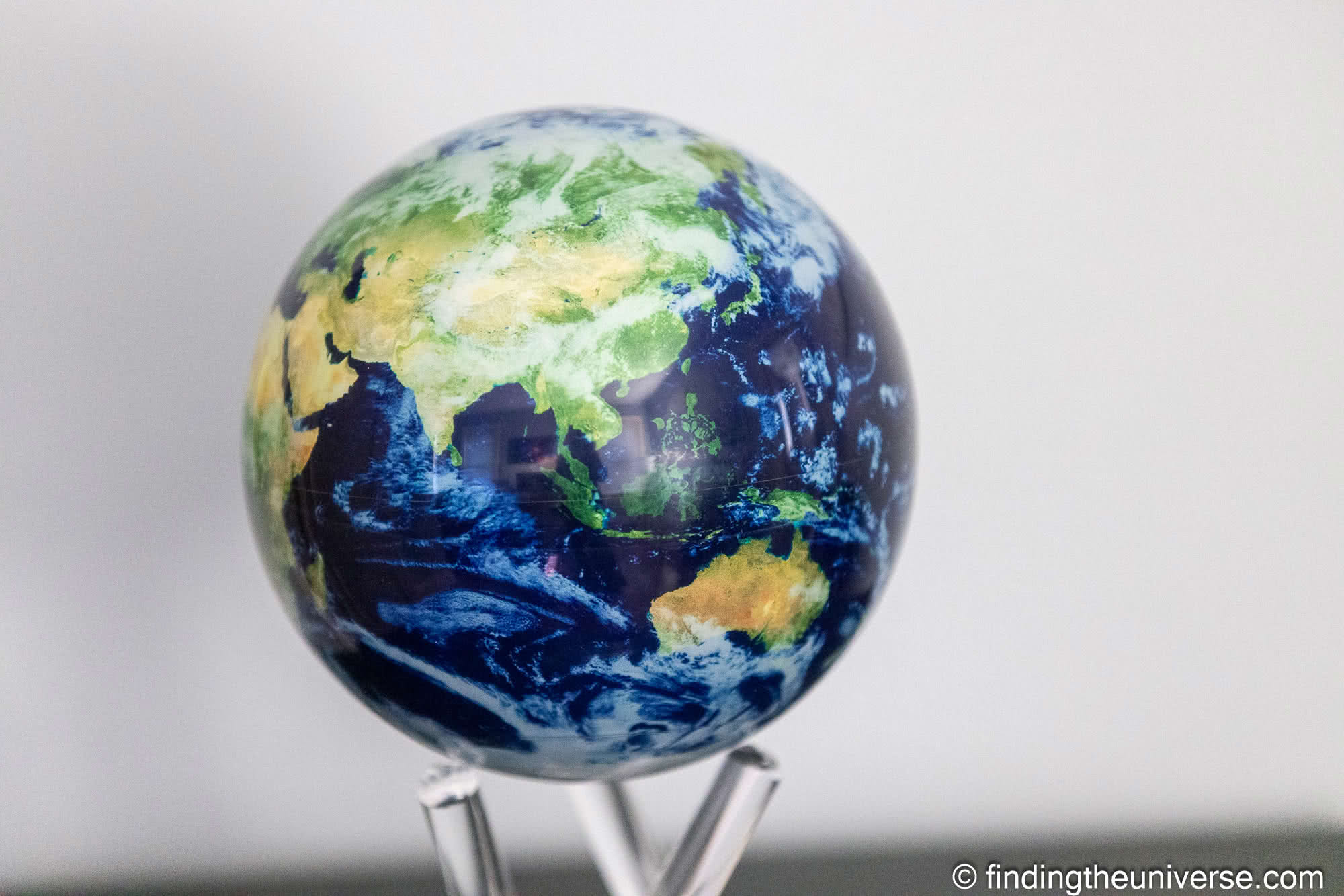

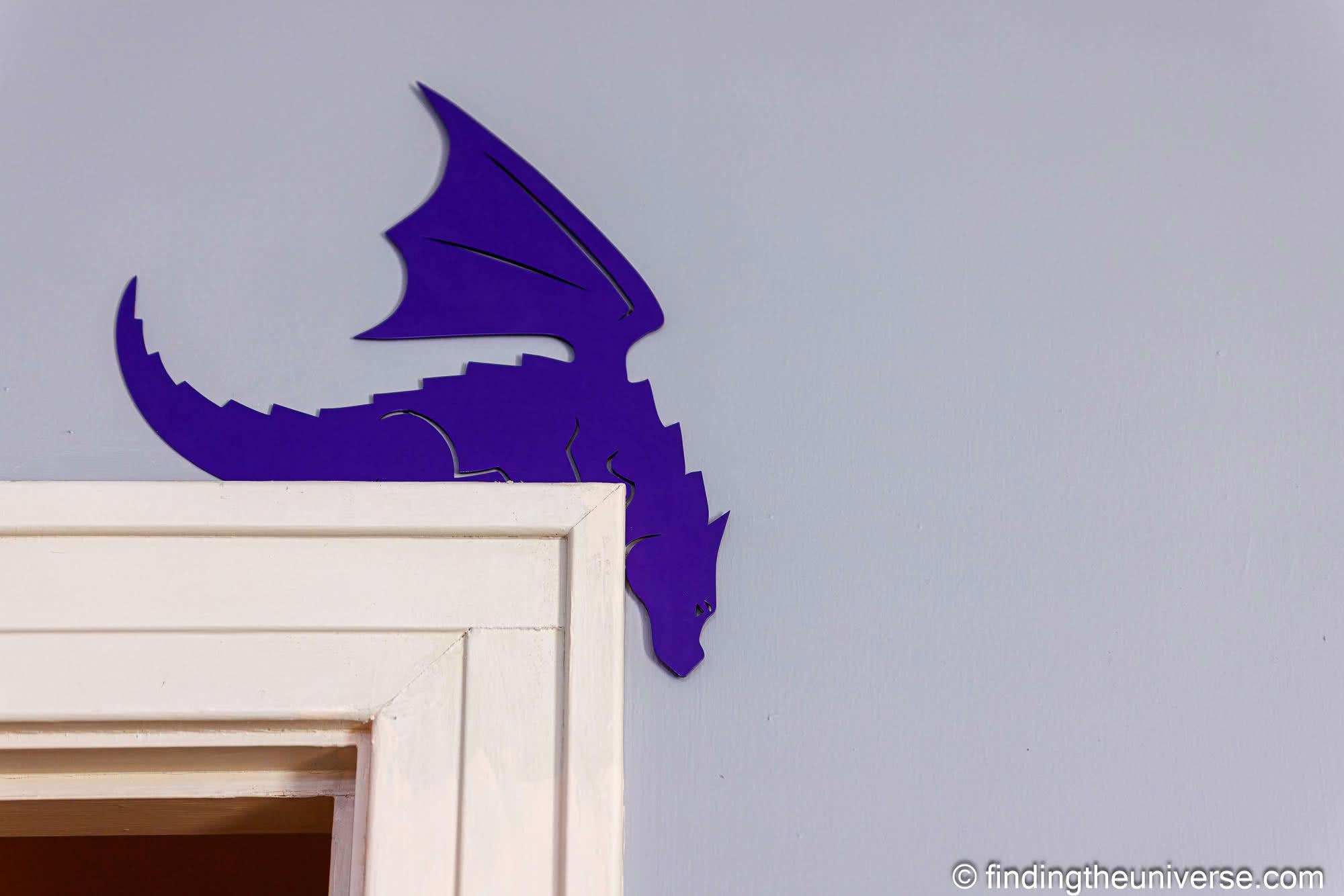

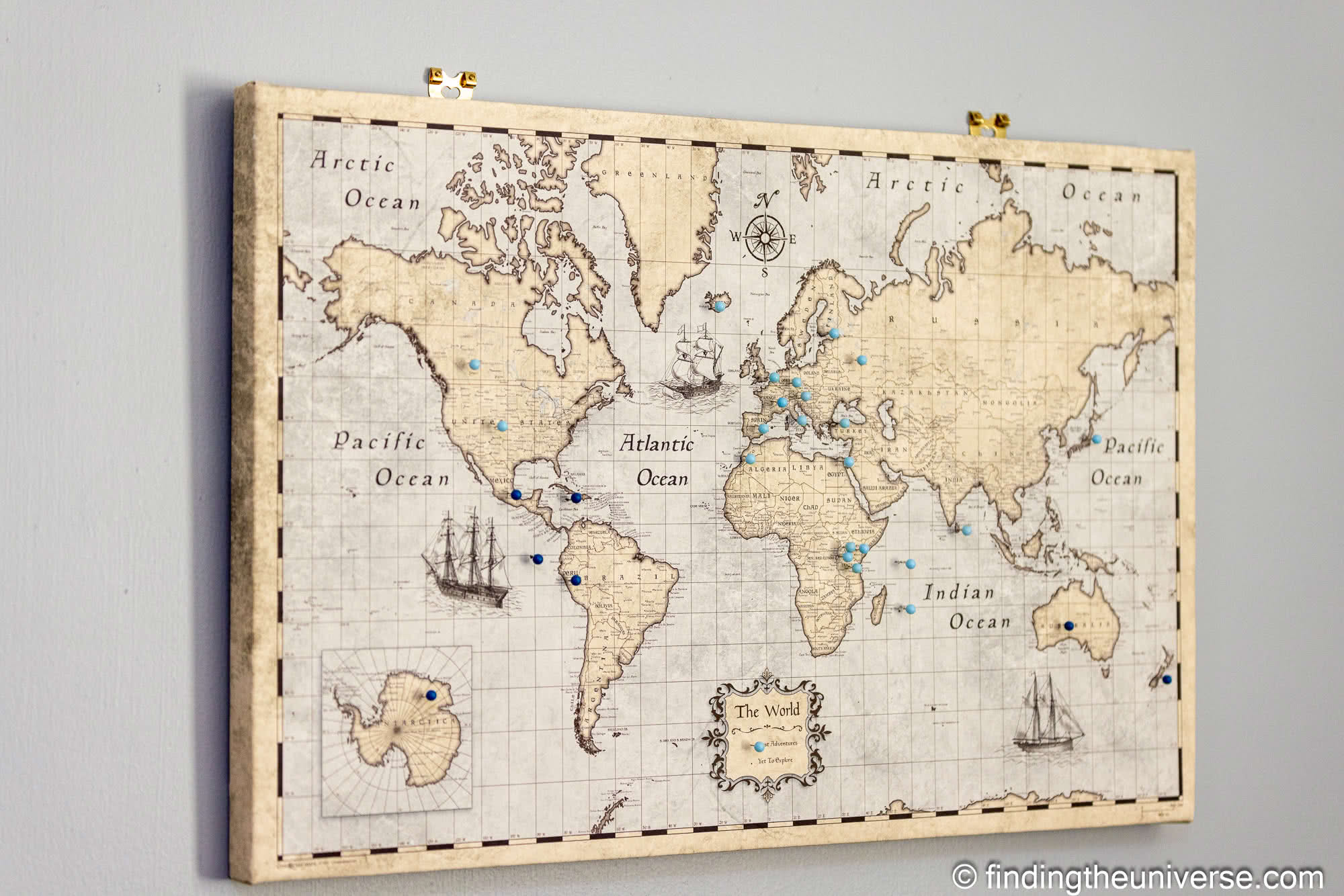

Further Reading
That’s it for my guide to setting up a home photography office! If you found this useful, you might enjoy some of my other photography related content. Here are some articles to get you started.
- I have a guide to starting a photography business, making money from your photography as well as a guide to how to sell your photos
- I have a guide to how to display your photos
- I have a guide to my favorite photo editing applications, as well as the best alternatives to Lightroom
- I have a guide to the best noise reduction software for some ideas on how to get the best out of your photos even when they might be a bit noisy
- We have a guide to how to use a compact camera, how to use a DSLR camera, and how to use a mirrorless camera. We also have a guide to how a DSLR works
- Knowing how to compose a great photo is a key photography skill. See our guide to composition in photography for lots of tips on this subject
- We have a guide to what depth of field is and when you would want to use it.
- We are big fans of getting the most out of your digital photo files, and do to that you will need to shoot in RAW. See our guide to RAW in photography to understand what RAW is, and why you should switch to RAW as soon as you can if your camera supports it.
- You’re going to need something to run your photo editing software on. See our guide to the best laptops for photo editing for some tips on what to look for.
- If you’re looking for more advice on specific tips for different scenarios, we also have you covered. See our guide to Northern Lights photography, long exposure photography, fireworks photography, tips for taking photos of stars, and cold weather photography.
- Color accuracy is important for photography – see our guide to monitor calibration to ensure your screen is set up correctly.
- If you’re looking for a great gift for a photography loving friend or family member (or yourself!), take a look at our photography gift guide,
- If you’re in the market for a new camera, we have a detailed guide to the best travel cameras, as well as specific guides for the best cameras for hiking and backpacking, the best compact camera, best bridge camera, best mirrorless camera and best DSLR camera. We also have a guide to the best camera lenses.
- If you want a camera or lens, but the prices are a bit high, see our guide to where to buy used cameras and camera gear for some budget savings options.
- We have a guide to why you need a tripod, a guide to choosing a travel tripod, a round-up of our favourite travel tripods and a review of the Peak Design Travel tripod.
Looking to Improve Your Photography?
If you found this post helpful, and you want to improve your photography overall, you might want to check out my online travel photography course.
Since launching the course in 2016, I’ve already helped over 2,000 students learn how to take better photos. The course covers pretty much everything you need to know, from the basics of how a camera works, through to composition, light, and photo editing.
It also covers more advanced topics, including astrophotography, long exposure photography, flash photography, and HDR photography.
You get feedback from me as you progress, access to webinars, interviews and videos, as well as exclusive membership of a Facebook group where you can get feedback on your work and take part in regular challenges.
It’s available for an amazing one-off price for lifetime access, and I think you should check it out. Which you can do by clicking here.
And that’s it! I’d love to hear about your thoughts and tips on what has worked for your home photography office and as always am happy to answer any questions you have. Just pop them in the comments below and I’ll get back to you as soon as I can.
